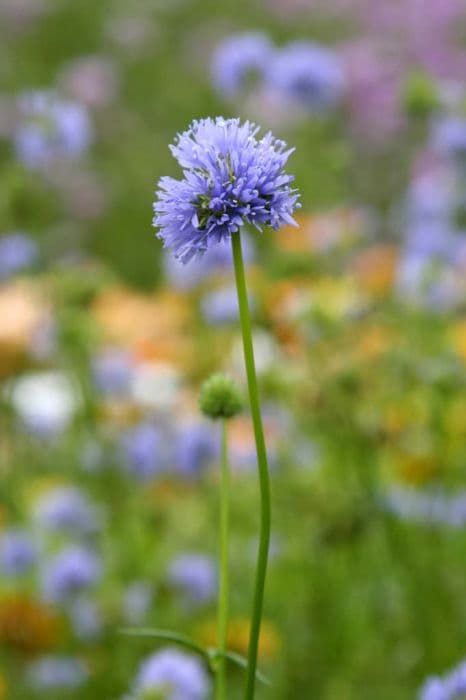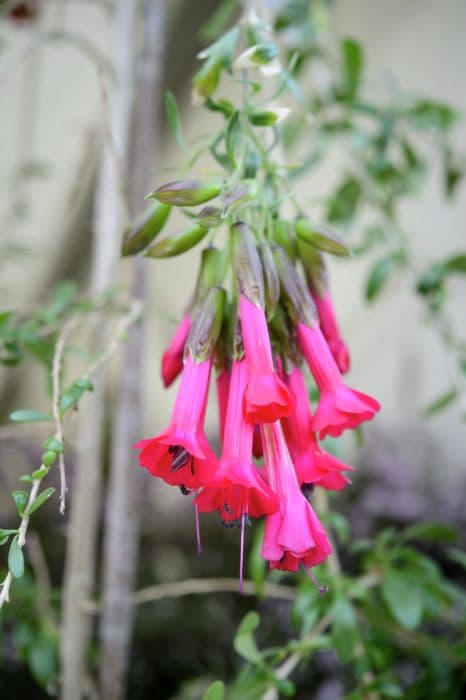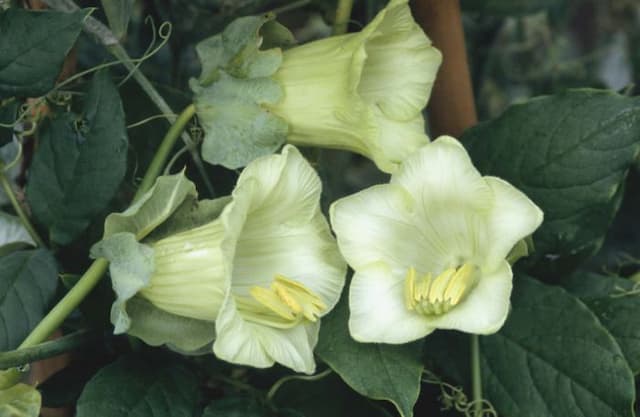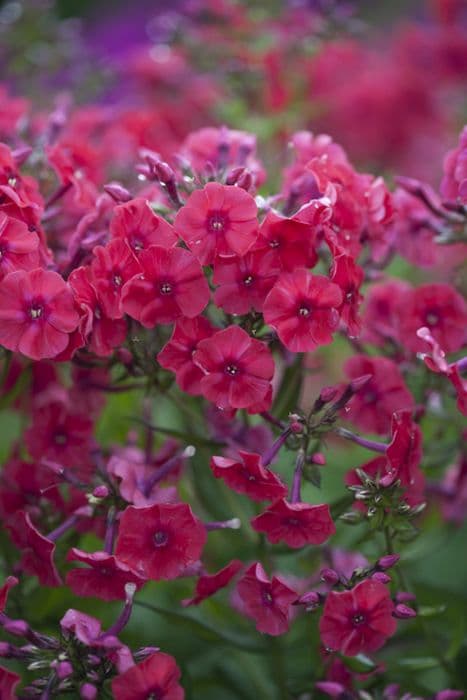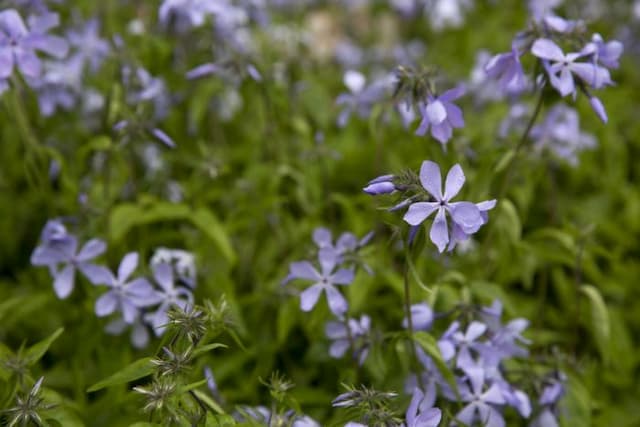Garden phlox Phlox paniculata 'Jade' (Neon Series)

ABOUT
Phlox paniculata 'Jade' from the Neon Series is a visually striking plant known for its vibrant and aromatic flowers. This phlox exhibits lush, deep green foliage that serves as a backdrop for its rich, showy blooms. The blossoms are known for their intense shade, which can range from neon to bright greenish-white, and they grow in large, dense clusters that generously cover the plant. Each individual flower within these clusters is shaped like a small tubular funnel with a flared, five-petaled mouth, adding texture and volume to the floral display. The blossoms exude a delightful fragrance that is especially prominent on warm summer evenings, inviting pollinators such as butterflies and hummingbirds to the garden. During its blooming period, the plant becomes a focal point in any garden setting, celebrated for its vivid color and enchanting scent.
About this plant
 Names
NamesFamily
Polemoniaceae
Synonyms
Garden Phlox, Summer Phlox, Perennial Phlox, Tall Phlox
Common names
Phlox paniculata 'Jade' (Neon Series).
 Toxicity
ToxicityTo humans
Summer Phlox is generally not considered toxic to humans. There are no widely reported cases of poisoning from consuming or touching Summer Phlox. Thus, ingesting parts of the Summer Phlox typically does not lead to poisoning or adverse health consequences.
To pets
Summer Phlox is not known to be toxic to pets such as dogs and cats. There is no significant evidence to suggest that ingesting this plant would cause poisoning in pets. However, as with any non-food plant, ingestion of large amounts could potentially cause mild stomach upset due to the plant material's irritative nature.
 Characteristics
CharacteristicsLife cycle
Perennials
Foliage type
Deciduous
Color of leaves
Green
Flower color
Pink
Height
2-4 feet (60-120 cm)
Spread
1-3 feet (30-90 cm)
Plant type
Herb
Hardiness zones
4-8
Native area
North America
Benefits
 General Benefits
General Benefits- Attracts Pollinators: Phlox 'Jade' (Neon Series) attracts butterflies and bees, which are beneficial for pollination in the garden.
- Colorful Blooms: Offers vibrant neon-colored flowers that add striking visual interest to any landscape or garden setting.
- Fragrance: The flowers of Phlox 'Jade' emit a delightful fragrance that can create a pleasant olfactory experience in the garden.
- Long Blooming Period: This variety has a lengthier blooming season compared to some other perennials, providing color for an extended time.
- Versatility: Suitable for borders, cottage gardens, and flower beds, providing versatility in landscaping and garden design.
- Low Maintenance: Once established, Phlox 'Jade' requires minimal care, making it a convenient choice for busy gardeners.
- Hardiness: Being part of the Neon Series, Phlox 'Jade' is generally hardy and capable of withstanding different climatic conditions within its hardiness zones.
- Herbaceous Perennial: As a perennial, it returns year after year, providing a reliable presence in the garden landscape.
- Cut Flowers: The blooms make excellent cut flowers for arrangements, bringing the garden's beauty indoors.
- Resistant to Deer: Typically resistant to deer, reducing the risk of damage from wildlife in areas where deer may be a problem.
 Medical Properties
Medical PropertiesThis plant is not used for medical purposes.
 Air-purifying Qualities
Air-purifying QualitiesThis plant is not specifically known for air purifying qualities.
 Other Uses
Other Uses- Photography Prop: Phlox paniculata 'Jade' can serve as an elegant backdrop for macro photography, highlighting its detailed structure and vibrant color.
- Symbolic Gift: Because of its perennial nature and beautiful blooms, giving a Phlox paniculata 'Jade' can symbolize a wish for long-lasting happiness in someone's life.
- Educational Resource: Horticulture and botany students can study the growth patterns, flowering mechanisms, and pollination ecology of Phlox paniculata 'Jade'.
- Artistic Muse: Artists may use Phlox paniculata 'Jade' as a subject for paintings, drawings, or textile designs, inspired by its unique neon coloration.
- Special Events Decoration: Its striking blooms can be used for decorating venues during events like weddings or garden parties, adding a natural charm to the setting.
- Culinary Decoration: Although not commonly known for its culinary uses, the flowers can be used as a non-toxic decorative element on cakes and desserts.
- Garden Borders: Phlox paniculata 'Jade' can be used to create vibrant, low borders for garden paths or flowerbeds, offering both aesthetics and organization to garden layouts.
- Eco-friendly Confetti: Dried petals of Phlox paniculata 'Jade' can serve as a biodegradable alternative to traditional paper confetti for celebrations.
- Color Themed Gardens: Phlox paniculata 'Jade' can be a crucial plant in a neon-themed garden design, providing focal points of bright color amidst other plants.
- Fragrance Pouches: The flowers can be dried and used in homemade potpourri or fragrance pouches, providing a subtle, natural scent to drawers and closets.
Interesting Facts
 Feng Shui
Feng ShuiThe plant Phlox is not used in Feng Shui practice.
 Zodiac Sign Compitability
Zodiac Sign CompitabilityThe plant Phlox is not used in astrology practice.
 Plant Symbolism
Plant Symbolism- Harmony and Unity: The dense clusters of Phlox paniculata blooms represent people coming together in harmony and solidarity.
- Proposal and Romance: Phlox's vivid and sweet-scented flowers are often used in bouquets to symbolize a marriage proposal or an expression of romantic feelings.
- Agreement: Phlox blooms, growing tightly together, symbolize souls being in agreement and the beauty found within concord.
 Water
WaterGarden Phlox should be watered regularly, about once a week, providing the soil around the plant with roughly 1 inch of moisture. During the peak summer months or in particularly hot or dry conditions, watering frequency may need to increase to twice a week. Use a soaker hose or drip irrigation to deliver water directly to the base of the Phlox paniculata 'Jade', avoiding wetting the foliage, which can lead to fungal diseases. In terms of water volume, this equates to about 0.623 gallons per square foot per week, so adjust according to your plant's size and the planting area.
 Light
LightGarden Phlox thrives best in full sun to partial shade. It should be planted in a location where it can receive at least six hours of sunlight daily, although it will appreciate some afternoon shade in extremely hot climates. Avoid deep shade locations, as this will reduce blooming and can increase the risk of disease.
 Temperature
TemperatureGarden Phlox is hardy and can tolerate a wide range of temperatures. It can survive minimum winter temperatures down to about -30 degrees Fahrenheit and is comfortable in summer temperatures up to approximately 85 degrees Fahrenheit. The ideal growing temperature for Phlox paniculata 'Jade' is between 65 and 75 degrees Fahrenheit.
 Pruning
PruningPruning Garden Phlox is essential to promote vigorous growth and prevent disease. Deadhead spent flower clusters to encourage additional blooming. After blooming has finished for the season, prune the plant back by about one-third to maintain a tidy shape and improve air circulation. The best time for thorough pruning is late winter or early spring before new growth begins.
 Cleaning
CleaningAs needed
 Soil
SoilGarden Phlox thrives in rich, moist, well-draining soil with a pH between 6.0 and 7.0. A good soil mix can be made by combining garden soil, compost, and perlite or coarse sand to improve drainage.
 Repotting
RepottingGarden Phlox does not typically require frequent repotting as it's a perennial. It should be divided every 3 to 5 years to maintain its vigor and manage its spread.
 Humidity & Misting
Humidity & MistingGarden Phlox prefers moderate humidity levels but is quite adaptable and can tolerate the varying humidity conditions commonly found outdoors.
 Suitable locations
Suitable locationsIndoor
Provide bright indirect light and regular watering.
Outdoor
Plant in sunny area with well-draining soil, water regularly.
Hardiness zone
4-8 USDA
 Life cycle
Life cyclePhlox paniculata 'Jade', commonly known as Garden Phlox, initiates its life cycle from seed germination, typically in spring when soil temperatures rise. The seedlings develop into robust plants with strong root systems and begin vegetative growth, producing lush foliage. As the plant matures and the days grow longer, it enters the flowering stage in early to mid-summer, producing clusters of fragrant, jade-colored flowers that attract pollinators. After pollination, the flowers develop into small fruit capsules containing seeds. With the arrival of autumn, Garden Phlox may enter a state of dormancy, with above-ground growth dying back as the plant prepares to survive winter using energy stored in its root system. Come the following spring, the cycle recommences as new shoots emerge from the roots, and the plant begins its vegetative and reproductive growth anew.
 Propogation
PropogationPropogation time
Spring to early summer
The most popular method of propagating Phlox paniculata 'Jade' (Neon Series), commonly known as Garden Phlox, is by dividing the root clump. This is best done in early spring or fall, when the plant is not in bloom. To propagate by division, carefully dig up an established clump of Garden Phlox, ensuring you have a good portion of the roots. Using a sharp knife, divide the clump into sections, each with a decent amount of root and at least a few shoots. Replant these divisions promptly, spacing them about 18 to 24 inches apart (approximately 45 to 60 centimeters). Water the new divisions thoroughly to help establish their root systems in their new locations.
